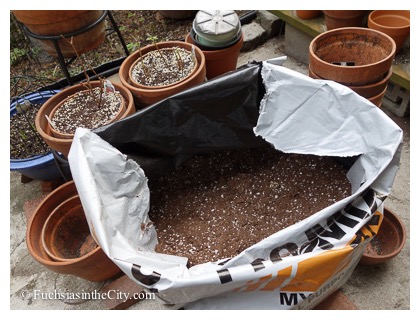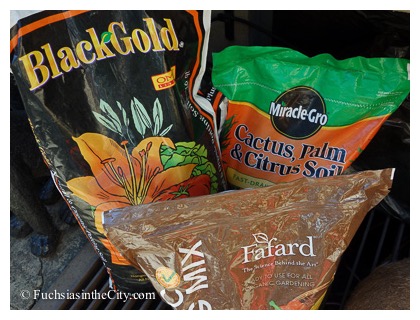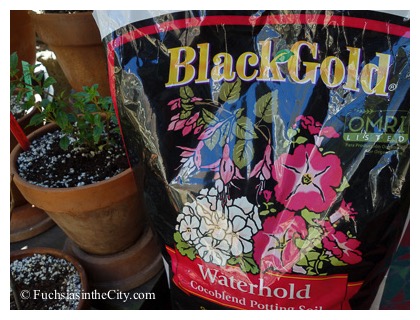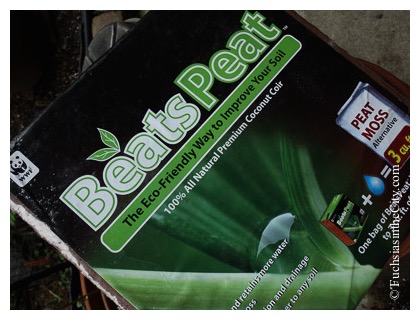
Care & Culture—A Guide to Growing Fuchsias
So. Where do I get the dirt? The great annual Central Park compost give-away? If I bring a cart, it's free for the taking... but is it good for my potted fuchsias?
So. Where do I get the dirt? The great annual Central Park compost give-away? If I bring a cart, it's free for the taking... but is it good for my potted fuchsias?
Choosing the right potting soils & mixes
Evenly moist but well drained
Over the years of growing fuchsias in the city, and even well before that, I've never noticed that they’re especially picky about what kind of potting mix I use as long as it meets a few basic requirements. It should be loose and well-draining, but not so much so that it dries out quickly.

Fuchsias generally like their soil to be kept evenly moist but not wet. If the mix you use regularly gets dry too quickly, there's a good chance your plants might simply drop the buds that make it all so worthwhile. Then the leaves might follow by slowly yellowing and falling away, as if going into dormancy.
Bone dry, however, will almost certainly kill the plants. They’re not cacti after all. If the mix retains too much moisture, or becomes water-logged, the roots will rot faster than you might think and the plant will suddenly collapse. Aeration and even moisture are important to fuchsia roots. Choose a mix that can provide both and your plants will flourish.
This preference isn’t too surprising. In the wild, many fuchsia species are often found near rivers, ponds and streams in places where, it seems, the dirt is rich and crumbly. Not swampy or waterlogged but where there’s a consistent source of underground water nearby. In other drier spots, a number of fuchsia species have evolved defense mechanisms in which they drop their leaves and go dormant during dry seasons.
Some have even developed tuberous roots to help them cope with a seasonal cycle of rains. Hints of this adaptation seem to be in much of the genus so don’t be surprised if a plant slowly puts on an autumn display if it’s gotten a tad too dry too often. This tendency can actually be helpful, though, if you need to store potted plants away for the winter in a semi-dormant state.
Soil-based composts
The John Innes family of composts is considered the gold standard for soil-based potting mixes. These recipes were developed in 1930 at the John Innes Center near London and there are four versions for sowing, rooting, potting and final growing. It’s great if you can make your own or be lucky enough to get it from a good supplier. Consider that it should be used fairly fresh and no more than a few months after mixing, as it can spoil and cause plants to fail.
or be lucky enough to get it from a good supplier. Consider that it should be used fairly fresh and no more than a few months after mixing, as it can spoil and cause plants to fail.
There are similar formulations available that are also quite fine for fuchsias. I should perhaps mention that simply using soil from your own garden isn't to be recommended at all, no matter how good you think your dirt is. It won't give good results and can harbor unwanted hitchhikers or diseases. As I said above, the main thing to look for is a mix that can give the fuchsia a healthy potted environment in which it can flourish.
Soil-based composts are good but there are a number of hybrid and soilless mixes that also produce excellent results. These are what I usually end up using at Fuchsias in the City anyway. Unfortunately, living in a large city, it's mostly impossible to get my hands on much quality soil-based compost. You can't just walk to the corner deli for it.
I may be able to get almost anything else delivered 24/7 by bicycle but not big bags of gold. Sure, Central Park offers a free give-away program of some of the nice compost it produces annually. You can show up with a wheelie cart or in a cab or with your limousine and driver and just haul some away for the taking.
Soilless composts
But it's only one ingredient in the recipe and I don't have the space to properly assemble and mix much of anything myself. I'd be able to pot a few small plants but what do I do when I need to pot on but have run out? Realistically and logistically, it's soilless mixes here and I try to find the best ones to keep the fuchsias happy.
 Besides, there are a lot of pluses to using soilless potting mixes in a small urban space. They have the advantage of being lighter and easier to carry in bulky bags if they're not fully moist. This is a major benefit to getting anything into an apartment garden. Its quality is generally consistent, It will hold fresh significantly longer than a pure soil-based mix. I can keep bags of it on hand for later.
Besides, there are a lot of pluses to using soilless potting mixes in a small urban space. They have the advantage of being lighter and easier to carry in bulky bags if they're not fully moist. This is a major benefit to getting anything into an apartment garden. Its quality is generally consistent, It will hold fresh significantly longer than a pure soil-based mix. I can keep bags of it on hand for later.
However, be aware that the lighter soilless mixtures dry out faster than the heavier mixes or the soil-based ones. Depending on the ingredients, sometimes a lot faster. This might be OK in larger containers that have the buffer of mass but it means that you have to keep a sharper eye on smaller ones or hanging baskets. Especially if you're in a warmer, drier climate. Or a windier one. You might find it helpful to add some water-retaining granules into some of these mixes. Rewetting can also be an issue with some of the soilless preparations. They may need to be soaked rather than top-watered to get them fully hydrated.
Of course not all commercial mixes, soilless or otherwise, are created equal. It used to be easier to buy a consistent potting mix from year to year but, with the need to lessen the use of peat moss taken from environmentally sensitive bogs, many alternative mixes are springing up. Now it's harder just to get the same mix from the same company in the same month, it seems.
I've noticed differing formulations popping up even within brands I assumed I knew well in seemingly identical bags bought from different stores in different areas. When potting on, plant roots don't necessarily grow easily from one kind of mix into another. Similarity is important and some mixes are better than others in meshing with what's already there when I need to buy more. I've found it helpful to actually inspect the contents of a batch whenever I can. I don't like hauling home bags of several cubic feet I thought I knew only to find it doesn't mesh well with what I started using for the fuchsias in the spring.
Coir-based composts
One of the major replacements for peat moss is coir, a fiber processed from the hulls of coconuts, that's being widely touted as "coco peat." It looks similar to peat moss but has quite different properties and characteristics. I’ve tried some mixes that use it but can’t say I'm fully sold on it. Perhaps it just takes getting used to the differences.

You'll see long lists of the advantages of using coir. It's natural and eco-friendly. It comes in convenient dry blocks you can store and hydrate as needed. It rewets well. It's anti-bacterial. That's good for rooting things or hydroponics. It drains well and holds about a thousand times more air than soil. Coir has a high cation exchange rate which means it absorbs minerals readily and is supposed to serve them back to the plant as needed. It seems perfect. What's not to love about it?
The advantages to using coir often seem very compelling because some of the disadvantages are rarely advertised. Most importantly, it can have seriously high levels of salt. A good amount of the manufacturing for separating the fibers from the husks uses sea water or salted water. A significant salt residue is left behind if the the coir isn't properly leeched for horticultural use. This salt will burn plants. It boils down to how honest and reputable is the supplier's supplier, I guess, and how much you want to trust your plants to them without testing every batch.
Coir is also not fully composted so it will compete with the plant for nitrogen as it slowly breaks down. If you're adding it to anything yourself, it's very hard to un-clump. You easily end up with lots of coir fur balls in the result if you're not careful and thorough. The cation exchange level is said to be similar to sphagnum moss but this may be good or bad depending on what's being absorbed and what's being released. Even with sphagnum, ever notice how "crusty" it can get? For fuchsias which are feed frequently but weakly, I'm concerned that the coir will retain more nutrient minerals than is ideal leading to root damage and struggling plants as the mix ages.
Will coir stand up for fuchsias? Time will tell. But it's also certainly time to get away from mining habitats for peat.
Shredded-bark composts
As an additive, finely shredded bark has been around in potting soil mixes for some time but it's increasingly seen as a easy alternative to peat moss. Its big brother is great as a mulch layered on the surface of the garden. Even in this small plot, I'll put down five to ten bags of it every year, or so, depending on how fast it decomposes. I've developed wonderful texture in the garden soil as a consequence.

But it's important how much and what kind of bark is being used in mixes. Redwood? Cedar? Pine? How fully is it composted? My experience has been that certain kinds seem to mold over easily under close cover. That might be good to help it nourish the forest floor but not so good to be composting in my fuchsia's pot. Or to be rooting cuttings in mixes with it as a major ingredient. I'm not quite sure what to make of the little mushrooms occasionally found growing around my fuchsias' stems either. Experimentation will continue though.
Confronted with an increasing and confusing array of choices, changes and ingredients, I've developed a renewed appreciation and pining for the good old-fashioned soil-based potting mix. The results in producing good healthy plants are time-tested and predictable. But it isn't readily obtainable or even practicable here. One day, maybe, I will just be able to pick some up on my way home along with the milk at the corner deli... In the meantime, I start with as good quality and well draining a mix as I can get, one into which my plants can happily establish themselves, and when it comes time for regularly adding nutrients, kinder, gentler and more frequent feeding is the way to go.
Over the years of growing fuchsias in the city, and even well before that, I've never noticed that they’re especially picky about what kind of potting mix I use as long as it meets a few basic requirements. It should be loose and well-draining, but not so much so that it dries out quickly.

Fuchsias generally like their soil to be kept evenly moist but not wet. If the mix you use regularly gets dry too quickly, there's a good chance your plants might simply drop the buds that make it all so worthwhile. Then the leaves might follow by slowly yellowing and falling away, as if going into dormancy.
Bone dry, however, will almost certainly kill the plants. They’re not cacti after all. If the mix retains too much moisture, or becomes water-logged, the roots will rot faster than you might think and the plant will suddenly collapse. Aeration and even moisture are important to fuchsia roots. Choose a mix that can provide both and your plants will flourish.
This preference isn’t too surprising. In the wild, many fuchsia species are often found near rivers, ponds and streams in places where, it seems, the dirt is rich and crumbly. Not swampy or waterlogged but where there’s a consistent source of underground water nearby. In other drier spots, a number of fuchsia species have evolved defense mechanisms in which they drop their leaves and go dormant during dry seasons.
Some have even developed tuberous roots to help them cope with a seasonal cycle of rains. Hints of this adaptation seem to be in much of the genus so don’t be surprised if a plant slowly puts on an autumn display if it’s gotten a tad too dry too often. This tendency can actually be helpful, though, if you need to store potted plants away for the winter in a semi-dormant state.
Soil-based composts
The John Innes family of composts is considered the gold standard for soil-based potting mixes. These recipes were developed in 1930 at the John Innes Center near London and there are four versions for sowing, rooting, potting and final growing. It’s great if you can make your own

There are similar formulations available that are also quite fine for fuchsias. I should perhaps mention that simply using soil from your own garden isn't to be recommended at all, no matter how good you think your dirt is. It won't give good results and can harbor unwanted hitchhikers or diseases. As I said above, the main thing to look for is a mix that can give the fuchsia a healthy potted environment in which it can flourish.
Soil-based composts are good but there are a number of hybrid and soilless mixes that also produce excellent results. These are what I usually end up using at Fuchsias in the City anyway. Unfortunately, living in a large city, it's mostly impossible to get my hands on much quality soil-based compost. You can't just walk to the corner deli for it.
I may be able to get almost anything else delivered 24/7 by bicycle but not big bags of gold. Sure, Central Park offers a free give-away program of some of the nice compost it produces annually. You can show up with a wheelie cart or in a cab or with your limousine and driver and just haul some away for the taking.
Soilless composts
But it's only one ingredient in the recipe and I don't have the space to properly assemble and mix much of anything myself. I'd be able to pot a few small plants but what do I do when I need to pot on but have run out? Realistically and logistically, it's soilless mixes here and I try to find the best ones to keep the fuchsias happy.

However, be aware that the lighter soilless mixtures dry out faster than the heavier mixes or the soil-based ones. Depending on the ingredients, sometimes a lot faster. This might be OK in larger containers that have the buffer of mass but it means that you have to keep a sharper eye on smaller ones or hanging baskets. Especially if you're in a warmer, drier climate. Or a windier one. You might find it helpful to add some water-retaining granules into some of these mixes. Rewetting can also be an issue with some of the soilless preparations. They may need to be soaked rather than top-watered to get them fully hydrated.
Of course not all commercial mixes, soilless or otherwise, are created equal. It used to be easier to buy a consistent potting mix from year to year but, with the need to lessen the use of peat moss taken from environmentally sensitive bogs, many alternative mixes are springing up. Now it's harder just to get the same mix from the same company in the same month, it seems.
I've noticed differing formulations popping up even within brands I assumed I knew well in seemingly identical bags bought from different stores in different areas. When potting on, plant roots don't necessarily grow easily from one kind of mix into another. Similarity is important and some mixes are better than others in meshing with what's already there when I need to buy more. I've found it helpful to actually inspect the contents of a batch whenever I can. I don't like hauling home bags of several cubic feet I thought I knew only to find it doesn't mesh well with what I started using for the fuchsias in the spring.
Coir-based composts
One of the major replacements for peat moss is coir, a fiber processed from the hulls of coconuts, that's being widely touted as "coco peat." It looks similar to peat moss but has quite different properties and characteristics. I’ve tried some mixes that use it but can’t say I'm fully sold on it. Perhaps it just takes getting used to the differences.

You'll see long lists of the advantages of using coir. It's natural and eco-friendly. It comes in convenient dry blocks you can store and hydrate as needed. It rewets well. It's anti-bacterial. That's good for rooting things or hydroponics. It drains well and holds about a thousand times more air than soil. Coir has a high cation exchange rate which means it absorbs minerals readily and is supposed to serve them back to the plant as needed. It seems perfect. What's not to love about it?
The advantages to using coir often seem very compelling because some of the disadvantages are rarely advertised. Most importantly, it can have seriously high levels of salt. A good amount of the manufacturing for separating the fibers from the husks uses sea water or salted water. A significant salt residue is left behind if the the coir isn't properly leeched for horticultural use. This salt will burn plants. It boils down to how honest and reputable is the supplier's supplier, I guess, and how much you want to trust your plants to them without testing every batch.
Coir is also not fully composted so it will compete with the plant for nitrogen as it slowly breaks down. If you're adding it to anything yourself, it's very hard to un-clump. You easily end up with lots of coir fur balls in the result if you're not careful and thorough. The cation exchange level is said to be similar to sphagnum moss but this may be good or bad depending on what's being absorbed and what's being released. Even with sphagnum, ever notice how "crusty" it can get? For fuchsias which are feed frequently but weakly, I'm concerned that the coir will retain more nutrient minerals than is ideal leading to root damage and struggling plants as the mix ages.
Will coir stand up for fuchsias? Time will tell. But it's also certainly time to get away from mining habitats for peat.
Shredded-bark composts
As an additive, finely shredded bark has been around in potting soil mixes for some time but it's increasingly seen as a easy alternative to peat moss. Its big brother is great as a mulch layered on the surface of the garden. Even in this small plot, I'll put down five to ten bags of it every year, or so, depending on how fast it decomposes. I've developed wonderful texture in the garden soil as a consequence.

But it's important how much and what kind of bark is being used in mixes. Redwood? Cedar? Pine? How fully is it composted? My experience has been that certain kinds seem to mold over easily under close cover. That might be good to help it nourish the forest floor but not so good to be composting in my fuchsia's pot. Or to be rooting cuttings in mixes with it as a major ingredient. I'm not quite sure what to make of the little mushrooms occasionally found growing around my fuchsias' stems either. Experimentation will continue though.
Confronted with an increasing and confusing array of choices, changes and ingredients, I've developed a renewed appreciation and pining for the good old-fashioned soil-based potting mix. The results in producing good healthy plants are time-tested and predictable. But it isn't readily obtainable or even practicable here. One day, maybe, I will just be able to pick some up on my way home along with the milk at the corner deli... In the meantime, I start with as good quality and well draining a mix as I can get, one into which my plants can happily establish themselves, and when it comes time for regularly adding nutrients, kinder, gentler and more frequent feeding is the way to go.
Chapter II
Potting Soils & Mixes
Potting Soils & Mixes
Chapter III
Propagating & Potting Up
Propagating & Potting Up
Chapter IV
Growing On
Growing On
Chapter VI
Pinching & Shaping
Pinching & Shaping
Chapter VII
Special Shapes
Special Shapes